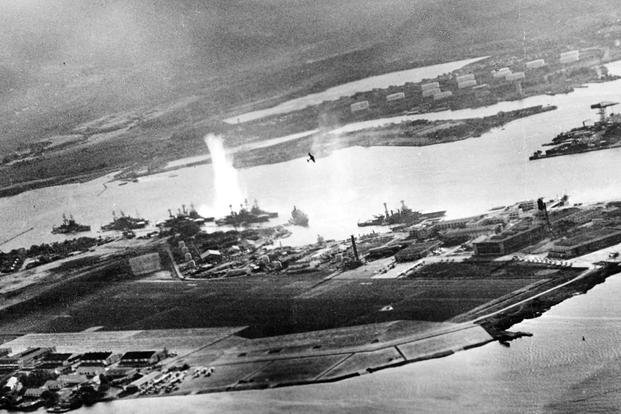As ships exploded and bullets rained down on the USS Nevada, sailors and Marines scrambled to their battle stations. But for the military band aboard the ship that day, their station was right where they already were, playing the national anthem of the United States.
Just over 75 years ago, the Empire of Japan hit the U.S. Navy’s Pacific Fleet at Pearl Harbor in an early-morning sneak attack that was designed to make the Americans give in before the war even started.
Attacks on the Naval Air Station at Ford Island and Wheeler and Hickam Army Air Fields, along with the ships in the harbor, brought more than 3,400 casualties. Some 2,300 were killed, along with the losses of 180 aircraft and 18 ships were sunk or run aground during the attack, including five battleships.
One of those ships was the Nevada, moored at the end of Battleship Row, and hit by a torpedo in the first wave.
Bandleader Oden McMillan and his 23 men had been in position since 7:55 a.m., when the blue prep signal went up. Unbeknownst to them, it was also the same time the attack on Pearl Harbor was set to begin.
As the band formed up to play morning colors at 8 a.m., they noticed something strange in the distance -- 183 planes of the first attack wave, along with kicked-up dirt and sand -- and thought it was another exercise.
When 8 o’clock came, McMillan struck up the band and began the national anthem.
Astern of the USS Arizona, the Nevada was a favorite target of Japanese Zeros that had released their bombs on Arizona but still had room to attack. Again and again, the decks of the Nevada were strafed by the enemy.
But the band played on.
It’s said the guns of the first Zero to strafe Nevada’s deck sprayed at the band first, but missed entirely, hitting only the flag and the wooden deck around them.
But the band played on -- albeit much faster than when they’d started. They played until the anthem was complete.
Only when the final note was over, the men finally broke formation and ran for cover, a scene immortalized forever in the classic World War II film, “Tora! Tora! Tora!”
The Nevada was eventually able to get underway because she was the last in the line of battleships. Then the oldest battleship in the Pacific Fleet, she had been retrofitted with torpedo protections that allowed her to resist the effects of the hole in her forward port side.
A half-hour after taking the hit in the first wave, she was moving toward the mouth of the harbor. This movement made the ship an instant target to dive bombers, and she was hit repeatedly by bombs, torpedoes and bullets as she steamed toward the Navy Yard.
Crewman worked like mad to turn the ship with the help of tugboats, but she was taking on water and was beginning to sink. She would eventually find herself run aground on a coral ledge near the Navy Yard, where she would stay for months before being raised and repaired.
In all, five battleships and two cruisers would be raised and fight the Japanese once more. Nevada would get back at the Japanese, providing naval fire support for the invasions of Attu, Iwo Jima and Okinawa.
-- Blake Stilwell can be reached at blake.stilwell@monster.com.
Want to Learn More About Military Life?
Whether you're thinking of joining the military, looking for post-military careers or keeping up with military life and benefits, Military.com has you covered. Subscribe to Military.com to have military news, updates and resources delivered directly to your inbox.















